
From the stunning Cathedrals of Europe to beautiful statues like the Venus De Milo now housed in the Louvre, art has been such a huge part of what I like to think of as the common human culture, the elements of the world that are universally admired. It has been invaluable to the growth and progress of mankind. The Renaissance period brought color to the world in a way previously unimaginable. Some of the greatest works of art have been the culmination of madness, struggle, hard work, and sheer talent. In keeping with that spirit, here are the stories behind some of the most famous works of art in the world.
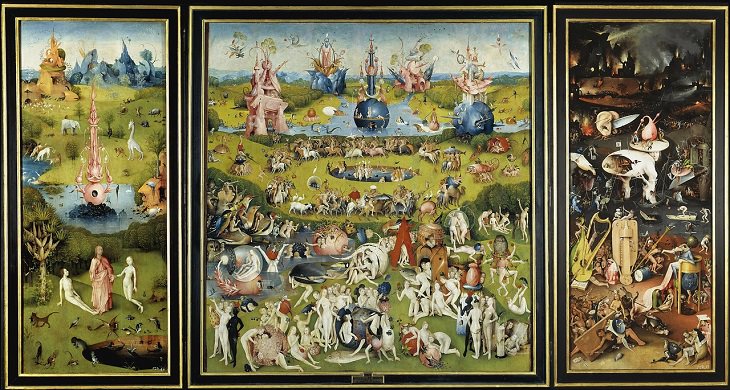
This beautiful triptych oil painting was created on an oak panel by an artist from Netherland, Hieronymus Bosch (my new favorite name), in the late 15th and early 16th centuries. The artist was in his 40’s to 50’s during the period he was painting this piece. As you can see, this piece has three panels, depicting what we can assume is Heaven, Earth, and Hell respectively.
The actual name of the piece isn’t publicly known, which is why the title for the center panel “The Garden of Earthly Delights”, became the common name. It has also been known in the past as the “strawberry painting”. This is because of the abundance of strawberries and strawberry trees throughout the canvas. While people have made speculations as to why the artist had such a fixation on this fruit, but given the little information revealed by the painter, it can only ever be speculation.
Ignoring (for now) the Wonderland-esque imagery and what many of the figures appear to be doing, the picture itself is extraordinarily large, spanning approximately 7 feet in height and 13 feet from end to end. And Bosch had a penchant for never signing the date on his work, so no one is quite sure when he started and when he finished. It is just assumed to have been completed somewhere between 1490 and 1510.
At the time when Bosch was painting the Garden of Earthly Delights, oil paints were actually relatively new (less than 100 years) and still being improved with respect to binding agents and comfort of strokes. This makes the intricacy of this painting all the more impressive.
This painting gained fame quickly, from 1517 onward, at which time it was housed in a town palace in Brussels. This was a year after the artist died. It was the Spanish Civil War that finally gave this painting a permanent home when it was finally moved from the home of King Phillip II (who purchased it by auction in 1591). In 1939, it was shifted to the Prado Museum which till today remains the safehouse for this masterpiece.
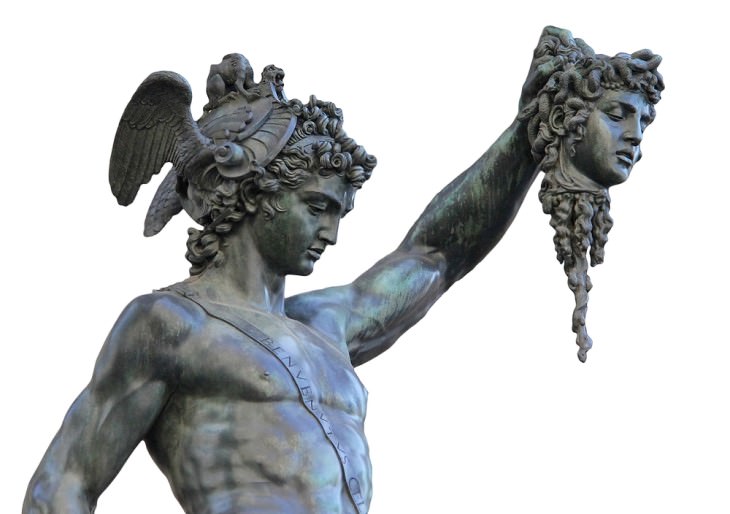
Greek Mythology has been a major influence on different forms of Art for many years. The Piazza della Signoria, in Florence, Italy, houses many statues depicting amazing tales from Greek Mythology. One such sculpture, and perhaps the most popular, is the statue made from bronze, entitled “Perseus with the Head of Medusa”, by artist Benvenuto Cellini.
So what is the story that inspired this masterpiece? Well, to start at the beginning of the mythos itself would be too taxing (to write or read), so here’s the short version, which reads like a made-for-TV drama. Perseus was the son of one Danae and the God Zeus, who impregnated Danae by entering her in the form of golden rain (stay with me here).
Danae had been locked away by her father, King Acrisius, who was told by the Oracle that his own grandson was to one day kill him. After hearing news of the birth of his grandchild, he was unphased and set his daughter and the child on an arc to be ravaged by the sea. But it’s not so easy to kill a son of Zeus.
They eventually came to the shores of Serifos Island where they were accepted by the brother of the Islands King and his wife. As years passed, Perseus grew into the demi-god he was meant to be, and the King’s brother eventually took a place on the throne. Wanting Danae for himself and knowing that Perseus was his only obstacle, he sent Perseus away on a mission to bring back the head of Medusa.
Medusa and her two sisters were known as the Gorgons, monsters in the form of fair maidens. After refusing advances from the god Poseidon (brother of Zeus), the Gorgons were turned into monsters with a tangled weave of snakes instead of hair on their heads. And though Medusa’s face remained beautiful, anyone who dared look upon it would immediately be turned to stone. So Perseus knew he needed some help.
He approached the Hermes (the original Speedster, Messenger of the Gods and Jack of all trades) and Athena (daughter of Zeus and Goddess of Wisdom). Hermes equipped him with winged sandals for speed and flight, a helmet for invisibility (because a cloak is too mainstream), while Athena gifted him a sword and shield. Prepared for battle, he approached the lair of the Gorgons.
In this case, the shield proved to be mightier than the sword because it allowed Perseus to see Medusa’s reflection and never have to look upon her face. He quietly moved closer to her and cut off her head while she slept. In some tales, it is said that the blood spilled from Medusa lead to the birth of the Pegasus (the winged horse) and the Chrysaor (the winged boar), children of Poseidon (who, some stories say, raped Medusa in a temple of Athena).
Armed with the head of Medusa, Perseus fled from the remaining Gorgons to return to Athena and Hermes. On the way, Perseus faced a number of other perils, because a hero’s work is never truly done. The head of Medusa proved to be a formidable weapon and saved him from many dangers in his travels.
In the sculpture, he is depicted holding out the head of Medusa in front of him. Some say this was a symbol of victory to Perseus. But, in this writer's humble opinion, looking at the way he keeps his head down, it can also be assumed that this is how he would have used the head of Medusa to immobilize his foes, knowing the horrors that it could inflict. But I am by no means an expert (or even an amateur for that matter) in understanding art, so take a look at the sculpture and decide for yourself!
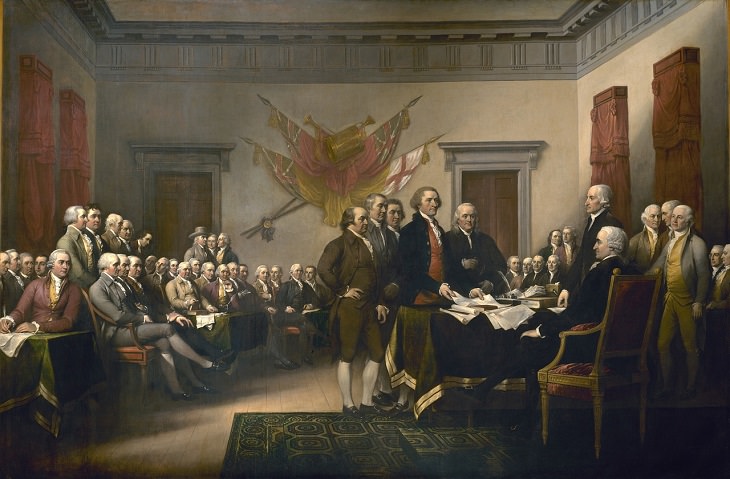
While the actual document is also most definitely a work of art, I am talking about the painting commissioned to be made in 1817 by John Trumbull. While many assume that this picture is meant to depict the signing of the Declaration of Independence, it actually captures a different but equally important moment in history. This painting depicts the moment when the first draft of this historical document was first brought before the Second Continental Congress, on June 28th, 1776. It was signed within one week.
In the center of the painting stands a group of men. These men are Robert Livingston, Roger Sherman, John Adams, and Benjamin Franklin, with Thomas Jefferson leading them. Together, these men formed the committee that drafted this document that would change the future of an entire nation.
Just for a quick history brush up (because I needed one, too) the Declaration of Independence was drawn up to lay down the principles that the Revolutionary War was being fought for, and the very ideals of freedom that still hold firm today. And the man seated before them, whose consideration gave this document its true and due value, is none other than the President of the Continental Congress, John Hancock.
John Trumbull was originally commissioned by the U.S Congress to make 4 pictures demonstrating scenes from the Revolutionary Era. The Declaration of Independence was the first completed one. While his original intention with this piece was to make a small but accurate depiction of what occurred at this event, he finally took a different route. He instead chose to memorialize the Nation’s founders.
Out of the 56 signatories to the Declaration of Independence, this portrait illustrates 42 of these great men, in all of their dignified glory. A total of 47 founders are depicted in the photo, 5 of whom were not signatories to the Declaration, but true-blooded patriots all the same. The 14 remaining signatories, Trumbull refused to paint, as he could not find an “authoritative” enough image to create their likeness and give them due justice.
One of the more interesting (perhaps amusing) things about this painting is that the decor depicted in Independence Hall included by Trumbull in the portrait, such as the grand Venetian curtains, and captured British Flags decorating the walls, were not actually there in the room. These were embellishments by the painter who believed that was what the room would have looked like.
In addition to that, some other architectural features, like the placement of the doors and windows, are also incorrect as they were based upon an inaccurate description given by Thomas Jefferson (whose memory didn't hold so strong in this regard alone).
This historical masterpiece has been placed in Capitol Hill since its commission in the early 19th century. It is also depicted on the $2 bill, in which the image has been altered slightly so that the feet of the Drafting Committee are further apart from each other. This stemmed from speculations that Thomas Jefferson appeared to be stepping on the feet of John Adams, representing the political tension between them.
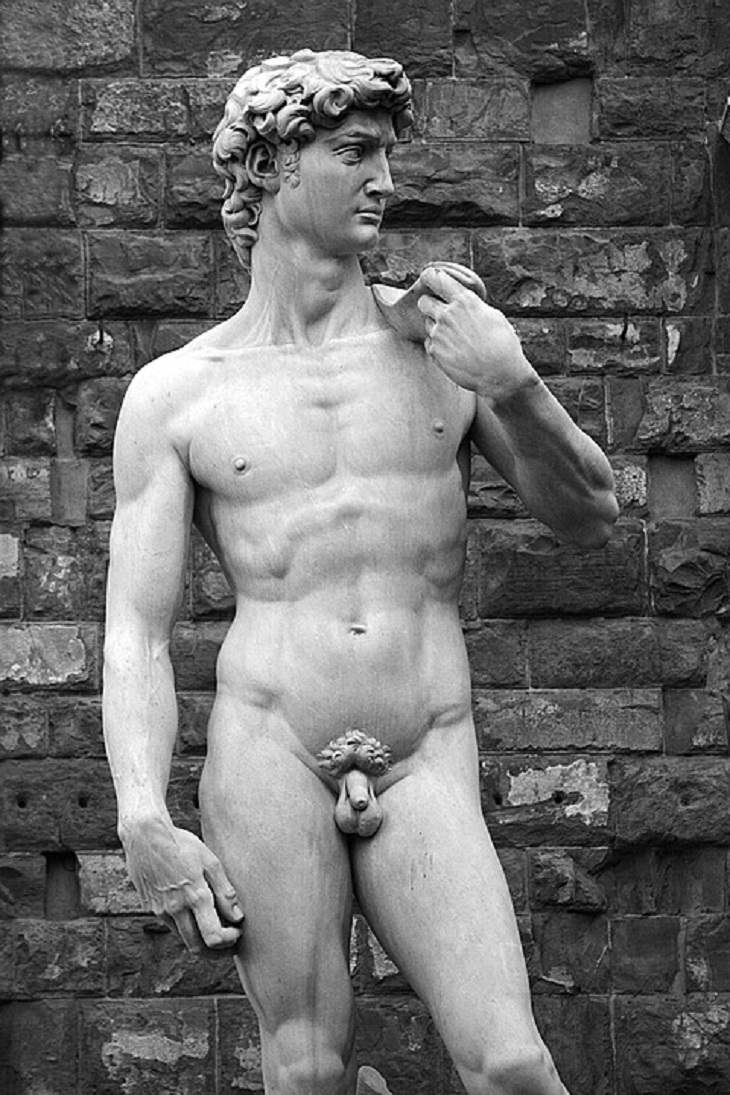
This absolutely infamous work of art was always thought to be the image of a man looking strong and imposing. However, very few people have actually looked at the face of this magnificent sculpted man because its place in the Galleria dell’Accademia in Florence has been facing a column since 1873 (more than 350 years after its creation).
After taking a closer look at the entire sculpture, two doctors from Florence noted numerous micro-details in this amazing piece. The right leg of David is tensed nervously, and his eyebrows are furrowed in what can be interpreted as fear and aggression, nostrils fully flared.
While most depictions of David from the Renaissance Era, by Florentine artists show a victorious David, after battle, it has been confirmed that Michelangelo instead chose to present David just before the throes of battle, readying himself for the hardships of combat. His eyes and body remain wary and tense, as he prepared to attack.
The beauty of this depiction is that it shows David not just for the warrior he was, but for the thinker he was well known as. His slingshot is perfectly arched over his shoulder and gripped in his hand, hiding it from the sight of the enemy (and onlookers) while still being optimally placed for use. Perhaps to signify that David’s victory over Goliath can be attributed to his concentration, confidence, and intelligence as opposed to sheer brute force.
In this representation, David is shown as using the contrapposto, standing such that one leg (in this case the left) bears most of the weight. This, in turn, makes the shoulders and arms twist away from the legs and the hips. This is a “counterpose” (direct Italian translation), to twist the upper extremities off-axis from the hips and legs, making the figure look larger, stronger and more dynamic.
The large block of marble that Michelangelo transformed into the sculpture"David" had actually been abandoned by the previous two artists commissioned to use it. For 25 years, this marble slab remained untouched in the courtyard of the Opera del Duomo, until 1501, when the renowned artist began work on this masterpiece that would come to find an everlasting place in history. He completed it finally in 1504.
Michelangelo’s dedication to the perfection of art can be seen in this stunning sculpture, which towers over all gazers and passerby at a whopping 17 feet tall (5.16 meters). That’s almost the size of the three tallest members of your family stacked one on top of the other. The attention to detail, like the tensing of the leg and the ridges on every knuckle, are all indications of the incredible talent of this artist, who would soon after begin work on the ceiling of the Sistine Chapel, one of his greatest works of art.
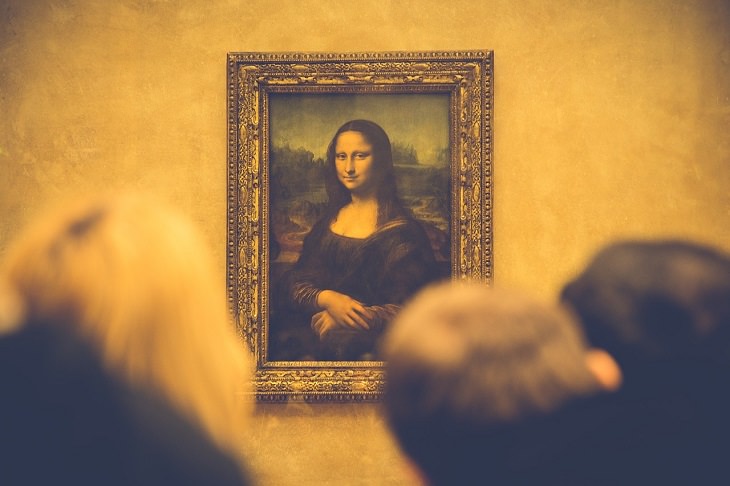
This beautiful Madonna has her own room in the Louvre, designed specifically for her protection. A creation of the great artist Leonardo Da Vinci, the Mona Lisa has captured the heart of art-lovers and the general public alike world over. So what is it that made this seemingly simple portrait so captivating?
Let’s start with the woman herself, seen sitting amidst a landscape, with a center of calmness and quiet about her. The Mona Lisa, also known as La Gioconda, depicts the wife of one Francesco Del Gioconda. The word “Gioconda” itself in Italian translates literally to the happy one. Therein lies the beauty of Mona Lisa’s smile, the simplest sign of the ideal of happiness and contentment.
In most works of art, especially those of the 15th and 16th century (this work of art having been created in the early part of the latter century), the symbolism and soulfulness of the characters depicted were usually only brought out through gestures, objects, and inscriptions. Da Vinci’s most famous work strived to bring out the soul of the fair Lady through her eyes and her smile, making her a living enigma, with a soul you can see but never get close to.
Now let’s look into the background. At the chest level of the Mona Lisa lies a winding road, leading into a distant bridge with greenery all around. These landscapes have been painting in bright and warm colors to depict the world of Man, places of familiarity.
However, as you move further back, the landscape changes, into rockier mountainous terrains, and never-ending streams of water. The artist began this landscape at the eye-level of the sitter, and used heavier and thicker strokes, to shown the wilderness beyond the worlds we know and inhabit. For added fun, if you take the closest of close looks at this enigma’s right eye, you will see the artists initials.
While the Mona Lisa is, in its simplest form, a portrait of a woman sitting in an open lodge, many have argued that the intended ideal that the picture brings forth, one of joy and happiness of a soul unreachable and untouchable by the unknown, it is by no means a traditional portrait. It has also been admired for its depiction of the connectivity between nature and humanity.
Before finding a permanent home at the Louvre, she originally had a place with King Francois I for over a century. It was then that King Louis the XIV removed her from her previous owner's possession and placed her in the Grand Palace of Versailles. It was just before her shift to the Louvre that the Mona Lisa also sat in the boudoir of Napolean Bonaparte.
In 1911, when the portrait was stolen from the Louvre (for which Pablo Picasso was once suspected though no evidence found), the world panicked to find it and cheered wholeheartedly when it was returned two years later. Since her arrival to the Louvre in 1815, the Mona Lisa has been the recipient of numerous flowers and love letters. Her mysterious and aloof demeanor still continues to seize the attention (and hearts) of people all across the world.

Most people have heard of this stunning painting by Vincent Van Gogh, which earned him much fame and prominence posthumously. But how much do you really know about this amazing piece of art (and history)?
Well, for starters, this painting was eventually studied by astronomers, who determined that this rendering of the skyline just before sunrise was actually a very accurate illustration of what the sky looked like that morning. While many have assumed the myriad of stars and swirling clouds was an exaggeration by the painter, it was what Van Gogh was actually gazing at.
Now moving on to bigger facts. Where was Van Gogh when he was gazing at this stunning field of blue? He was, at the time, a resident of Saint-Remy-de-Provence Asylum, and the picture is meant to capture the view from his asylum room. He had been admitted there after severing his left ear.
Until recently, the belief was that on 23rd December 1888, Van Gogh had an argument with his friend, roommate and fellow artist Gaugin, that became heated. Following this, he retreated back to his room where he proceeding to remove his left ear with a razor. He then promptly wrapped it up in paper and gifted it to some poor horrified woman at the brothel he and Gaugin used to visit frequently.
However, according to writer Martin Bailey, the real reason Van Gogh retreated to his room and performed the act of self-mutilation that would forever come to be a symbol of the depths of creative madness, was because he had received news that his brother (and benefactor) had become engaged and was soon to be married, which shook the artist to his core. In his book Studio of the South, Bailey shows evidence of Van Gogh receiving this news before severing his ear, and not after, as was originally believed.
Regardless of the reason, a policeman found him the next morning unconscious (presumably from blood loss) and he was taken to the hospital where he woke up with no memory of what had occurred. After diagnosing him as suffering from “acute mania with generalized delirium”, he spent a number of months moving in and out of this hospital. He finally chose to admit himself to the Saint-Remy-de-Provence Asylum, where he sought help for his mental condition and made many of what would become his most famous works of art. One amongst these (perhaps the most notable?) is none other than Starry Night.
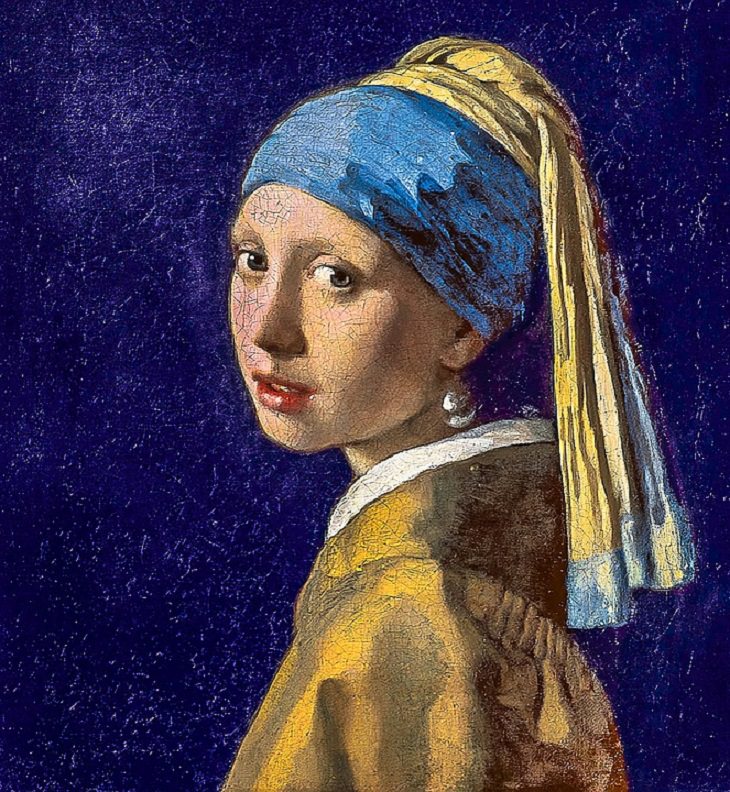
This work of art was the one out of 36 solitary pieces of art created by the 17th century Dutch Painter, Johannes Vermeer. While the true story behind its origins has been lost to time, many speculations as to what it (and she) represents have been put forth. However, one of the most well known was in a book written in 1999 by Tracy Chevalier, a fan of Vermeer and his paintings, which goes by the same name as the painting.
The story follows the life of Griet, a sweet, shy and humble young woman (16 years old) from a family of moderate means, caught in a time of financial struggle. To help her family, she takes up a job as a full-time live-in servant with the painter and his family. This story happens over the course of two years.
While her quiet and calm demeanor helped her to complete her household duties, it also caught the attention of Vermeer, and consequently that of his wife Catharina and his mother-in-law, Maria Thins. All the ingredients necessary for a real-life drama.
Vermeer quickly noticed the young girl’s keen eye for the arts and put her to work in his studio, teaching her how to mix paints and other small jobs. His paintings were usually focused on women in different settings of the home, so he would also use her as a stand-in for his subjects. His wife was less than thrilled about this, what little she knew of it.
Her mother, on the other hand, the main benefactor of Vermeer and owner of their home, saw the potential Griet had to help Vermeer enhance his art career. She quietly works toward shifting more of the girl’s duties towards his painting career, again to the displeasure of her daughter. Cornelia, the six-year-old daughter of Vermeer and Catharina, mischievous by nature and volatile like her mother, notices everything, making life as hard as possible for the young Griet.
In the meantime, Griet gains the attention of many others, with her quiet demeanor and lovely face. Pieter, the butcher's son, courts her vehemently and helps her struggling family to cope with their financial burden. However, Vermeer’s most wealthy patron, and main subscriber to his art, Van Ruijven, also takes an interest in her and is not a man that takes no for an answer. The story takes a darker tone as Van Ruijven takes every opportunity he can to molest and attempts to pressurize the artist to paint a picture of him and the young lady together.
Vermeer recounts the last time he allowed his patron to sit for a painting with his previous maid, and how that ended in that young woman becoming “ruined”. Hoping to avoid a repeat of the catastrophe, he agrees to paint a single portrait of Griet alone for Van Ruijven to purchase. For this painting, he forces Griet to pierce her ears, and quietly takes his wife’s pearl earrings, without her knowledge of course, for the young maid to wear while sitting for the portrait.
Enter the ever-observant child Cornelia, who takes the opportunity to allow her mother to discover the indiscretions occurring and then watch the scandal unfold. Catharina bursts into her husband's studio and catches him in the act of painting Griet, who she finds wearing her scarf and pearl earrings. Vermeer remains silent to the words of his weeping wife, and finally, Griet is forced to leave.
The story ends, however, ten years later when the artist passes away and Griet is reunited with the pearl earrings once again, though only briefly.
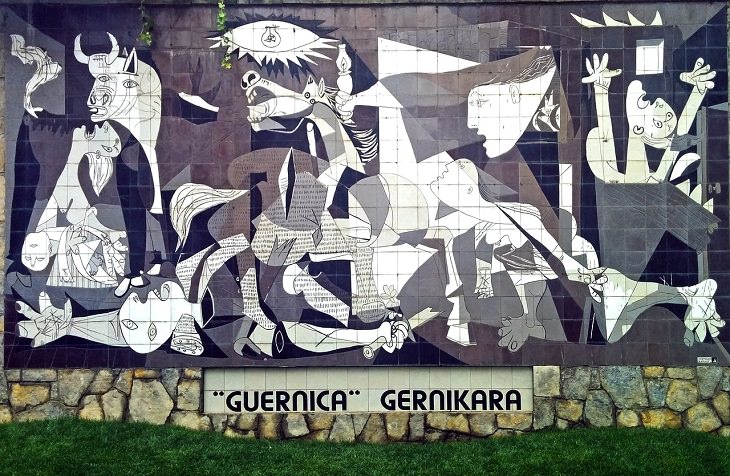
This work of the infamous Pablo Ruiz Picasso is one of the most renowned and profound pieces of art from the 20th Century. This painting was Inspired by a tragic event that occurred amidst the political turmoil that was taking place at the time. Despite not being well received at its time, it would one day come to be recognized as a strong symbol against the Nationalist aggression during the Spanish Civil War.
The Spanish Civil War began in July of 1936 when a Spanish General named Francisco Franco organized a coup that split the country down the middle, as Nationalists, and the surviving members of the democratic republic. This war eventually reached the global political sphere, with everyone picking sides. While the Soviet Union came forward in support of the Republicans, Germany was equally quick to arm the Nationalists.
For the ten years before the Spanish Civil War escalated, the Spanish Painter had been experimenting with the artistic concept of surrealism, and though he started his painting career with still life pictures of normal items like musical instruments and fruits, he eventually began using his art to break the usual form of these traditional themes and present them from different perspectives. It was his unique style of art that would make him live forever in infamy.
At the time when the war began to intensify and internationalize, the artist from Málaga had been commissioned to produce a mural by the Spanish Government for the Paris Exhibition of 1937. Struggling with the depression so oft faced by the tortured artists, and with a heart made heavier by the escalation of the war now raging through his home country, Picasso stood stuck in time, his creative process in absolute disarray. Then in April of 1937, an event occurred that would change everything.
On the afternoon of 26th April 1937, the crew of a British battleship sailing off the coast of Northern Spain called the HMS Hood, watched in absolute silence as a barrage of military planes from Germany and Italy assembled in the skies above. Their mission was simple. Bomb the city of Guernica.
Like rain of fire falling from the sky, the Italian and German bombers laid waste to the small Basque city. A war correspondent ran to report what he saw, arriving at the city almost 10 hours later, the flames were still burning from all ends of the city. A small place with mostly wooden buildings, the fire spread quickly and grew with a vengeance.
The original thought was that the city was bombed to reduce weapons supplies as Guernica had a weapons manufacturing plant. But when the flames died down and the dust settled, the factory and even the war barracks were amongst the few buildings still left standing. It was violence to create terror and intimidation, and an offer made by General Franco for Adolf Hitler to test his weapons, in repayment for arming the Nationalists.
On reading the news of the horrors that occurred in Guernica and shaken to his core, Picasso knew his three-month long search for a mural was over. His piece, entitled “Guernica”, was unveiled at the Spanish Pavilion of the Paris Exhibition. While it received very little praise at the time it was unveiled, it soon came to be a symbol of the fight against fascism, oppression, and terrorism, showing in beauty and vivid detail the horrors that befell to the people of the city of Guernica.
This painting was returned to Spain in 1981, where it was kept in the Prado Museum for a little over ten years, before finally being moved to the Reina Sofia Museum. One of its most frequent visitors and great admirer is another brilliant artist, Jackson Pollock.
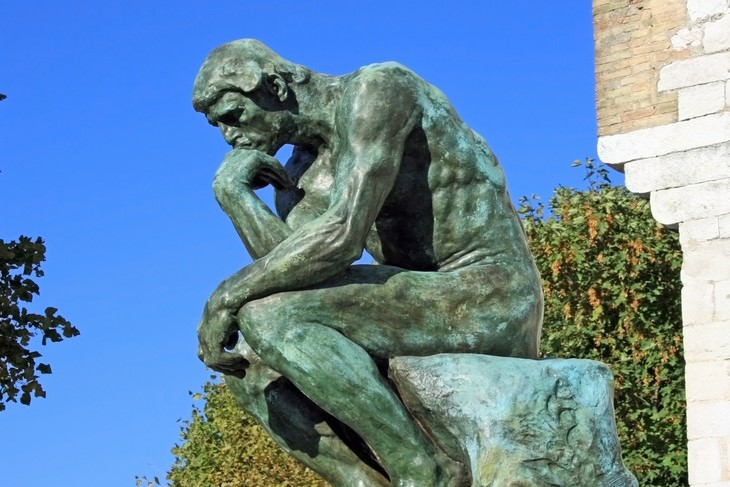
La Penseur, translated to “The Thinker”, is one of the most well-known works of French artist Auguste Rodin, and you might even remember him from his appearance in the film, Night At The Museum (2006). A larger than life (physically and mentally) naked man, seated on a rock with his head resting on his fist, this statue, and that pose, have come to be recognized as symbols of one lost in philosophy.
The original concept for the Thinker was actually meant to be The Poet, and he was first created in the mind of Rodin as a part of “The Gates of Hell”. This was a project Rodin had been commissioned to do, following the journeys and travels through hell as described in Dante’s Inferno, the first story of the Divine Comedy.
This epic poem describes the journey of Dante Alighieri through the seven circles of hell, witnessing a different punishment for each sin. His goal is to climb out of the very depths of Hell and to do so, you must go through it.
The Artist was meant to create the very gates to Hell (as an entrance to a planned museum) and engrave upon them the images of all the characters of the poem and their suffering in that endless chasm. The Poet sits above, silent and observant, ever in thought about the destruction happening below him. While neither the museum nor the gates to Hell were ever built, the original plaster for the Gates to Hell can be found at Musee d’Orsay.
The Thinker nonetheless went down in infamy. Rodin even used him as a teaching tool in many of his workshops so there are numerous different versions of the slender but muscled man all across the globe, some made of bronze and others of marble.
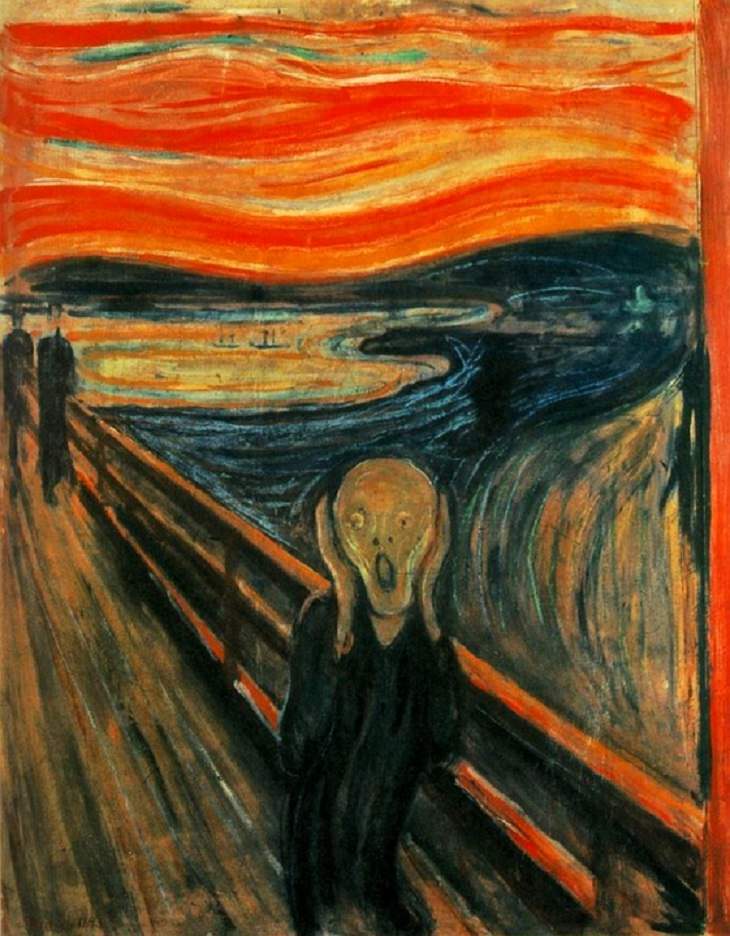
This piece by Edvard Munch is arguably one of the most famous paintings in the world, even though the Painter’s name isn’t heard much. An image of a lone androgynous figure standing on a bridge, the only thing that can truly be identified is the unmistakable fear on the figures face, with both hands clasped against the cheek in horror. You can almost hear the bloodcurdling shriek this terrorized soul is screaming.
Painted in the late 19th Century, this picture was the brainchild of a unique era of art, which had transitioned from still-lifes into expressions of the soul. Artistic talent became a creative outlet for the artist's innermost thoughts, doubts, desires, joys and most relevant, fears. So what pushed the mind behind this canvas streaked with bright colors but dark undertones?
Over the years, the diaries of Edvard Munch were discovered and studied in an attempt to learn the meaning behind the incomprehensible. After all, every form of art is just the minds way of communicating its madness to the world. But just because you communicate it, doesn’t mean you understand it.
However, many accounts retold in his story do point to possibilities as to what brought this painting out and moved the hand of the artist. The painting by the Norwegian artist was originally entitled Der Schrei der Natur, translating to, “The Scream Of Nature”. This was also the name of a poem written by the artist in 1895, adapted from a diary entry he had written three years previously.
"I was walking down the road with two friends when the sun set; suddenly, the sky turned as red as blood. I stopped and leaned against the fence, feeling unspeakably tired. Tongues of fire and blood stretched over the bluish black fjord. My friends went on walking, while I lagged behind, shivering with fear. Then I heard the enormous infinite scream of nature."
This poem gives some clarity to the painting. To begin with, the painter speaks of his exhaustion, which is understandable given he struggled with severe anxiety for most of his life, starting at the tender age of 5 when his mother died from tuberculosis. However, he also says he “heard” the scream of nature, so it can be reasonably presumed that he wasn’t the one doing the screaming. So where did the sound come from?
If you read the poem a second time, perhaps you’ll notice his multiple uses of the word “blood”, to describe the color of the sky and the fading seascape, as he stands on the bridge. According to his diary, there was a slaughterhouse not far from where the picture is believed to have been illustrated. In another cruel twist of fate, the mental asylum where his own sister was a resident was also nearby. Perhaps the artist was haunted by the terrible screams of animals being dragged to their fates. Or worse perhaps, the anguished screams of the inmates of the mental asylum, his sister’s voice drowned amidst all the chaos.
Great pain and suffering have a way of forcing a man (or a woman) to reach deep within them to pull out creations that make us think, feel, laugh and even weep. Edvard Munch was the creator of more than 1000 paintings, most of which were donated to the Norwegian Government following his demise. This painting continues to be remembered through another form of art, be it the small homage paid to it in the movie Home Alone, or the movie franchise Scream. Though there are many versions of The Scream out there (4 of which are by Munch), the first and original is currently in Oslo as a part of the Nasjonalgalleriet (National Gallery).
Related Articles:
Top 16 Paintings Inspired by the Bible
13 Paintings that Changed the Art World